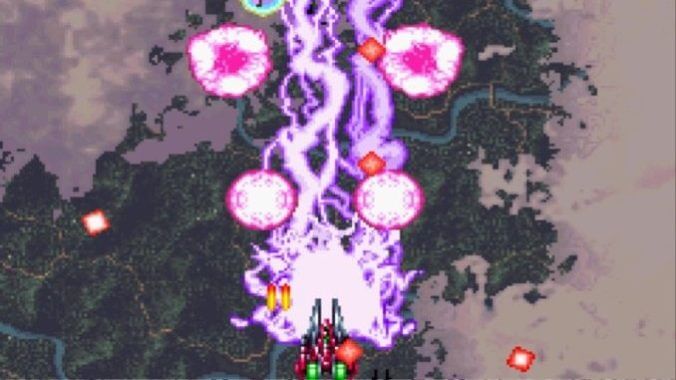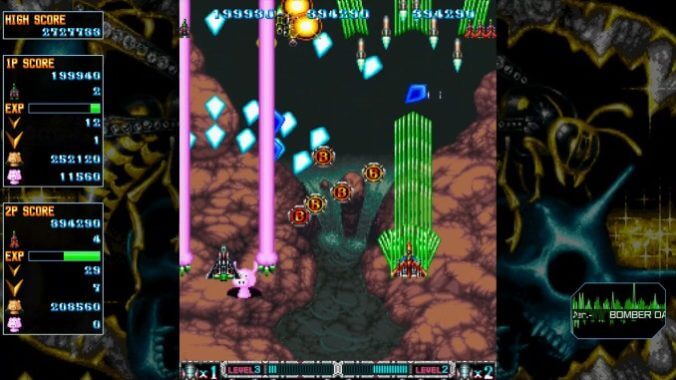
A home release of Batsugun will arrive worldwide on May 25. It’ll be the first time ever that the now-30-year-old shoot ‘em up will be available as a standalone purchase outside of Japan. The original arcade incarnation of Toaplan’s STG swan song received a worldwide release, but its home port was a Sega Saturn exclusive, and, like so many other wonderful titles on that console, it never left Japan unless an importer with taste to match their wallet ordered a copy. And while you could grab it as part of Sega’s Astro City Mini V—the “V” stands for “vertically oriented”—as of 2022, that’s a minimum $160 purchase before shipping that comes with 22 other shooters and just as many complaints about input lag.
Going from a paucity of Batsugun to an existence where it’s simultaneously available on the Nintendo Switch, Playstation 4, Xbox One, and Steam (with it of course also working on the backwards-compatible Xbox Series S|X and Playstation 5) is quite the shift, but it’s a welcome one. Batsugun isn’t just one hell of a shoot ‘em up: it’s also a wildly important one in the genre’s history. With it not being legally accessible in North America for decades, it’s been something of a missing link in the evolution of shoot ‘em ups for those outside of Japan. Batsugun is widely recognized as the first bullet hell shooter, and given that this is a term you now find well outside of the genre it originated in—we’ve got roguelike bullet hell games now, people—that’s some footnote.
And it all started with what would end up being Toaplan’s shooter swan song. Toaplan, known for classic shoot ‘em ups like Tiger-Heli, Twin Cobra, Truxton/Tatsujin, Flying Shark, and Zero Wing, would develop a sequel to Snow Bros. before their 1994 closure, but Batsugun was their last completed STG (Twin Cobra II began development before Toaplan shut down, but would be finished by another studio for publisher Taito). Batsugun might have been a great game, but it was released during a seismic shift in arcades: the age of the shooter was ending, while that of the fighting game was just beginning. Studios like Toaplan and fellow shoot ‘em up masters Compile struggled almost immediately; whereas Compile just stopped making shoot ‘em ups and focused on their wildly successful Puyo Puyo puzzle franchise instead, Toaplan had no such fallback plan. They made games that weren’t shooters, good ones, too, but their success in arcades and relationship with the likes of Taito is what helped keep them going on the financial side. When interest waned in their genre of choice, they first bled employees, then declared bankruptcy, and the studio was done in early 1994.
That would be the end of Toaplan as a studio, but only in name. Rather than rising like a phoenix with some new benefactor behind it, Toaplan reemerged more like the heads of a hydra. In Toaplan’s place grew Tamsoft, Takumi, Gazelle, Raizing, and the bullet hell developer, Cave. Beyond those five studios, a few Toaplan employees also went to existing major studios like Square and Taito, the latter of which was just hitting its stride with shoot ‘em ups even as the arcade popularity of the genre waned.
Tamsoft still exists, often working on the properties of other companies, but they also originated the Choro Q racing series and Toshinden, an early polgyon fighting game, in the ‘90s. Takumi ended up finishing Twin Cobra II for Taito, and went on to create three Giga Wing games for Capcom and Taito, as well as another arcade/Dreamcast STG, Mars Matrix. Gazelle didn’t last for very long after its creation, but it was around long enough to create Air Gallet, a compilation of Toaplan shooters for the Playstation, and to give Batsugun what was, until now, its lone home release.
The shoot ‘em up work of those other Toaplan offshoots was certainly good, but Raizing—also known as Eighting or 8ing—and Cave were on another level. Raizing is responsible for one of the single-greatest shoot ‘em ups ever in Battle Garegga, a masterpiece in manipulating “rank” that marries scoring and survival together in a way you don’t often see in an STG, as well as the Mahou Daisakusen trilogy of shoot ‘em ups, one of which is also a racing game. And there are plenty of people who will tell you that Raizing managed to make some games better than Garegga, too, which should tell you quite a bit about the quality on display.
And Cave, of course, is a legendary studio, with DoDonPachi, ESP Ra.De, Dangun Feveron, Mushihimesama, DoDonPachi Blissful Death… we’ll be here all day if I keep going. The president of Cave, Kenichi Takano, came over from Toaplan, as did Tsuneki Ikeda, the programmer and director of many a Cave game. Ikeda was a programmer on Batsugun, even, (And who eventually ended up at Cave working on some of their later shoot ‘em ups? Shinobu Yagawa, who was behind Battle Garegga as well as some of Raizing’s other offerings.)

Each of these studios dabbled, to differing degrees, with bullet hell conventions. Bullet hell, danmaku, manic shooters, whatever you want to call them, that was Cave’s whole deal, and the perfecting of this subgenre through added layers of complexity (and bullets) was clearly their goal. And one they achieved, time and time again. Eighting still exists but no longer deals in shoot ‘em ups, but when they did, they had no problems filling the entire screen with bullets and chaos, creating elaborate patterns for players to have to dart in between and through all while avoiding having anything clip their hit box. The Giga Wing games are bullet hell to the point it’s difficult to discern what’s happening on screen sometimes: shoot what’s shooting at you, and avoid everything that isn’t a collectable point multiplier, and you’ll be fine. Easier said than done, which is the bullet hell way, but you can get there with practice.
While the original Batsugun release lacked the infinite loops Toaplan shooters were known for, it still had that all-important feature that extended both the gameplay and the challenge. In the arranged mode Special release of Batsugun that updated the arcade original (which Gazelle included in the Saturn release and is also be part of the modern re-release of that title by City Connection; it’s otherwise unreleased outside of location testing since Toaplan went bankrupt before it saw the light of day as a full release), the second loop began on stage 2, the third on stage 3, and so on. Each loop was shorter, yes, but they’d cut out the easier stages, leaving you with more difficult versions of more difficult stages to complete: completing them all is no easy task, especially as the birth of bullet hell as a subgenre is taking place in front of your eyes, assuming you can live long enough to witness it all.
Batsugun isn’t quite as intense as what came after, no, but that’s no surprise. Still, it’s more than just playable 30 years after its initial release: it’s a delight. It might not seem all that manic at first despite its history as such a transitional title for shoot ‘em ups, but Toaplan was easing players into the idea of bullet hell and away from the kind of game they’d been developing for nearly a decade before that point. By Batsugun’s end, not only are you filling the screen with countless rounds, but your enemies are, too, and on the loops after you first “complete” the game? There aren’t just revenge bullets exploding forth from defeated enemies, but swarms of them that fill the screen up enough that there are times where it’s prudent to not shoot the second you see something, so that you can be sure there’s a place for your ship to escape to once you do. The more loops, the more bullets to dodge, revenge or otherwise, and enemies don’t necessarily repeat their movements and patterns from earlier loops, either.
In addition to its bullet hell history, Batsugun also featured an RPG element, with you earning experience points for each kill. Your ship can gain three levels, each of which powers up your weapon and changes its function so it can fire faster, cover more of the screen, hit harder, and so on. You don’t lose your level-based weapon power upon dying, either, so even as you respawn and aren’t granted any power-ups to recover with, you aren’t left helpless. You can also power up your weapon independently of your level, though. (And if you max out those power-ups, you can score quite a few bonus points by continuing to pick up the power-up items.) In Batsugun Special, you’re granted a shield to absorb one hit on the third level: it eats up some of your collected experience each time, so you’ll have to continue to defeat enemy ships to refill it and be granted another shield. So, you’re far from invincible even with this little boost, especially given how the game’s difficulty ramps by the time you’ve collected enough experience to even have a shield.
No surprise considering Ikeda programmed both Batsugun and the Cave games that put them on the map, but there is a whole lot of what would eventually be seen in games like DonPachi on display in Batsugun. Not just in terms of masses of bullets to dodge, either, but in ship design: each of the three ships you can choose from in Batsugun has an equivalent in DonPachi, and I don’t mean visually speaking. The weapon design, the upgrades for those weapons, how they grow and interact and all of that, is found in both of these titles. For the same reason Gazelle would release Batsugun on the Saturn a few years after Toaplan closed down, it’s not like there was anyone to protect the bankrupt company’s ideas besides those who had conceived them in the first place.
Batsugun is an important piece of videogame history that’s been hidden by circumstance from the eyes of those outside of Japan (or who aren’t obsessed with importing, modding, MAME, emulation, and so on). Now, though, this piece of connective tissue that served as the unofficial transition of shoot ‘em ups of the past to the bullet hell-driven ones of the future will be available worldwide, and it’s as much of a joy today as it was when Toaplan was working on its Special update nearly three decades ago. Buy it, play it, love it, or just admire that it’s even here now: Batsugun and the Toaplan employees who scattered after its release changed shoot ‘em ups forever, and in a way that’s got modern-day marketers for Sony-published Playstation 5-era exclusives like Returnal putting the words “bullet hell” in their copy. That’s some impact for a game most people have never even heard of, but maybe it’ll finally get its due all this time later.
Marc Normandin covers retro videogames at Retro XP, which you can read for free but support through his Patreon, and can be found on Twitter at @Marc_Normandin.